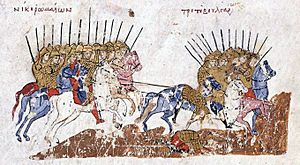Leo V the Armenian facts for kids
Quick facts for kids Leo V the Armenian |
|
|---|---|
| Emperor of the Romans | |

Depiction of Leo from the 11th century Madrid Skylitzes.
|
|
| Byzantine emperor | |
| Reign | 12 July 813 – 25 December 820 |
| Coronation | 12 July 813 |
| Predecessor | Michael I |
| Successor | Michael II |
| Co-emperor | Constantine |
| Born | c. 775 |
| Died | 25 December 820 (aged c. 45) |
| Consort | Theodosia |
| Issue | Constantine Basil Gregory Theodosios Anna |
| Father | Bardas |
Leo V the Armenian (born around 775, died December 25, 820) was a powerful ruler of the Byzantine Empire. He was the Byzantine emperor from 813 to 820. Before becoming emperor, he was a skilled general. He took the throne after his predecessor, Michael I Rangabe, stepped down.
During his rule, Leo V brought an end to a long war with the Bulgarians. He also started a new period of Byzantine Iconoclasm, which was a time when religious images were removed from churches. Sadly, he was killed by people who supported one of his trusted generals, Michael the Amorian, who then became the next emperor.
Contents
Becoming Emperor
Leo was the son of a high-ranking official named Bardas. His family came from Armenia. In 803, Leo served under a general named Bardanes Tourkos. However, Leo decided to support Emperor Nikephoros I instead. The Emperor rewarded Leo for his loyalty.
Later, Leo was called back by Emperor Michael I Rangabe in 811. He became the governor of an important area called the Anatolic theme. He did very well in a war against the Arabs in 812, winning a key battle.
Taking the Throne
In 813, the Byzantine army suffered a big defeat against the Bulgarians at the Battle of Versinikia. Leo V survived this battle, and he used the defeat to convince Emperor Michael I to give up his throne. On July 11, 813, Leo V became the new emperor.
To show he was a good Christian, Leo V wrote a letter to Patriarch Nikephoros. He wanted to assure the Patriarch that he would follow the traditional Christian beliefs. When he entered the palace, he even knelt before an important religious image of Christ.
Leo V's Rule
When Leo V became emperor, the situation was very difficult. The Bulgarian leader, Krum of Bulgaria, was blocking Constantinople by land.
Ending the War with Bulgarians
Leo V tried to negotiate with Krum and even planned an ambush to capture him. The plan failed, but Krum eventually left the siege of the capital. However, Krum captured and emptied cities like Adrianople.
When Krum died in the spring of 814, Leo V led his army to victory against the Bulgarians near Mesembria (Nesebar). After this important win, the two empires signed a peace treaty in 815 that lasted for 30 years. This brought much-needed peace to the empire.
Bringing Back Iconoclasm
Before Leo V, the emperors had supported the use of religious images, called icons. But some people believed that worshipping icons was wrong. This disagreement was called Iconoclasm. Since the previous emperors' policies were linked to defeats, Leo V decided to bring back Iconoclasm.
In 815, he removed Patriarch Nikephoros and held a meeting in Constantinople. At this meeting, they decided to stop using icons again.
The Emperor used this policy to take control of properties owned by those who supported icons, especially rich monasteries. He also chose strong military leaders from his own friends, like Michael the Amorian and Thomas the Slav.
Leo V's Assassination
Leo V was a strong leader, but he made some enemies. He suspected Michael the Amorian of planning against him and put him in jail.

However, Michael's supporters planned to kill the Emperor. On Christmas Eve in 820, Leo V was attending a church service. A group of assassins, pretending to be part of the choir, suddenly attacked him.
In the dim light, they first attacked the priest by mistake. This gave Leo a chance to grab a heavy cross and defend himself. He called for his guards, but the doors were blocked. Within moments, he was killed.
The assassins then rushed to free Michael II from prison. But Leo had hidden the key on himself. Since it was very early, they couldn't find a blacksmith. So, Michael was quickly crowned emperor with the iron chains still around his legs.
Leo's family, including his mother and his wife, Theodosia, were sent away to monasteries. His four sons were badly injured, and one of them died. Even people who didn't like Leo V agreed that he was good at managing the empire.
Leo V's Children
Leo V and his wife Theodosia had four sons:
- Symbatios (later renamed Constantine): He was co-emperor with his father from 814 to 820. After his father was killed, he was sent away.
- Basil: He was also sent away after his father's death. He was still alive in 847.
- Gregory: He was also sent away after his father's death and was still alive in 847.
- Theodosios: He died in 820, the same year his father was killed.
Some historians also believe Leo V might have had a daughter named Anna.
Images for kids
-
The body of Leo V is pulled through the Hippodrome.
See also
 In Spanish: León V el Armenio para niños
In Spanish: León V el Armenio para niños





